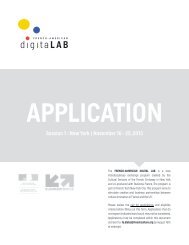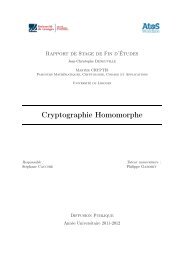REX
BD16_REX
BD16_REX
You also want an ePaper? Increase the reach of your titles
YUMPU automatically turns print PDFs into web optimized ePapers that Google loves.
Retours d’expériences Big Data en entreprise<br />
LESSONS LEARNED<br />
As with any project, a number of valuable lessons were learned by the Oxford University Press team as it developed<br />
its new platform and rolled out the African American Studies Center.<br />
Know<br />
./<br />
Understand<br />
./<br />
./<br />
Plan<br />
./<br />
your content. In addition to understanding the type of information and its structures,<br />
one must also understand how the content is interrelated. Possessing a deep understanding<br />
of the information enables you to fully define the content, its metadata, and its publishing<br />
requirements. You can then verify that the functionality you have planned properly<br />
leverages the content’s granularity. The information and relationships play directly into the<br />
design of the final product.<br />
that technology is not magic. In the end, technology is not a silver bullet that<br />
can do everything for you—it is a tool that enables you to speed the development and publishing<br />
of information. In the end, it will not provide 100% automation, nor will it eliminate<br />
the need to work directly with the information. If used correctly, however, technology can<br />
greatly improve the pace and effectiveness of creating and delivering information.<br />
Utilize an XML architecture to help ensure flexibility. Using XML helps to remove the dependency<br />
of information on any one particular technology, and this ultimately adds longevity<br />
to the information and platform. XML-based information can be aggregated with<br />
other information, automatically processed, and published in a more automated manner. It<br />
reduces the amount of direct interaction that is necessary to reuse or repurpose the content.<br />
An XML content server like MarkLogic Server can significantly improve this process.<br />
for iterations. Functionality, content, and metadata are often intertwined. For instance,<br />
metadata that was not used in the original content may be core to the online product.<br />
According to Alex Humphreys, “Iterations are about coordination. By cycling through these<br />
iterations, we can simultaneously mitigate risk while ensuring that the entire project team<br />
is working towards the same goal.»<br />
PRODUCT REFERENCE: MARKLOGIC SERVER<br />
Mark Logic Corp. helps its customers accelerate the creation of new information products. MarkLogic Server is<br />
an XML content server that enables organizations to build content applications, or applications that are based on<br />
content and that support business processes. With MarkLogic Server, companies can deliver products through<br />
multiple channels, integrate content from different sources, repurpose content into multiple products, build unique<br />
information products, and discover previously unknown information. MarkLogic has a complete implementation of<br />
XQuery, the W3C-standard for querying XML, and provides very fast and highly scalable content retrieval.<br />
San Mateo, California-based Mark Logic is privately-held and backed by Sequoia Capital and Lehman Brothers.<br />
The company serves large, recognized companies in the publishing industry, public sector, and other industries.<br />
MARKLOGIC SERVER OVERVIEW<br />
As MarkLogic Server is an XML content server, it is an ideal platform for content applications. With a native XML<br />
repository and a complete implementation of XQuery, MarkLogic provides robust support for:<br />
• Content loading: Content can be loaded in its current format, converted to XML as necessary, and automatically<br />
indexed for later retrieval. Supporting any number of DTDs or XML schemas, MarkLogic Server is able to make<br />
sense of a disparate array of content.<br />
• Query: With full-text and XML indexes accessible via XQuery, MarkLogic Server provides fine-grained search and<br />
retrieval based on document type, content structure, occurrence, and attributes.<br />
• Content manipulation: MarkLogic Server provides the means to transform, update, and even assemble new content<br />
products based on specific needs.<br />
• Rendering content: MarkLogic Server enables companies to format, publish, and deliver content products. If<br />
needed, MarkLogic can be integrated with other publishing technologies to facilitate the delivery of content through<br />
any number of media or channels.<br />
MarkLogic Server enables organizations with high-volume content needs to automate the processes of content<br />
integration, content repurposing, content delivery, and custom publishing.<br />
CONTENT INTEGRATION<br />
Many organizations have numerous disparate silos of content due to unique project needs, mergers and acquisitions,<br />
licensing, or changing corporate standards. Much of that content is maintained in different formats. Until the<br />
content has been integrated, however, its true value cannot be realized.<br />
MarkLogic Server bypasses the typical content normalization step by importing content “as is.” It uses the power of<br />
its query system to cut across all of the types and formats in a content base. MarkLogic supports loading, querying,<br />
manipulating, and rendering content in consistent ways even if there are no common DTDs, XML schemas,<br />
or formats. Furthermore, MarkLogic Server does not “shred” or “chunk” documents, so there are no problems with<br />
“round-tripping” documents to and from the content base. No information is ever lost.<br />
CONTENT REPURPOSING<br />
Content Publishers often need to repurpose content into multiple products to increase revenues, decrease costs,<br />
or accelerate time to market. The goal is simple—write once, use many. These organizations want to assemble<br />
content components to create customized, purpose-built documents and information products.<br />
Document réalisé par la Société Corp Events - Janvier 2015<br />
54







